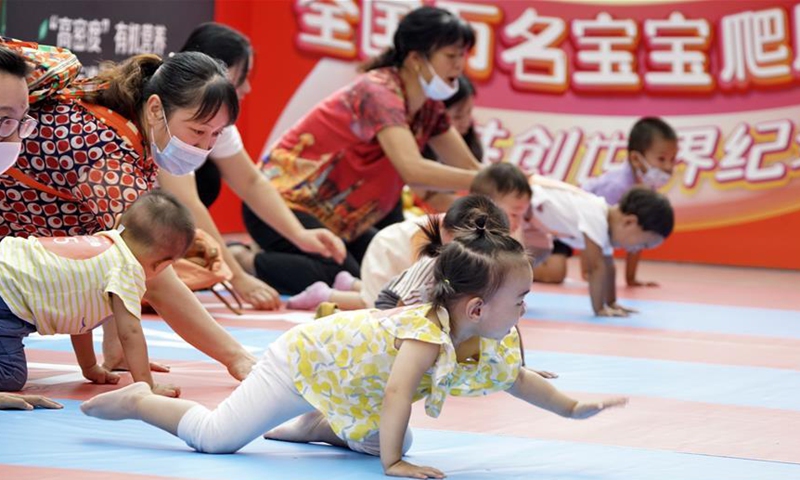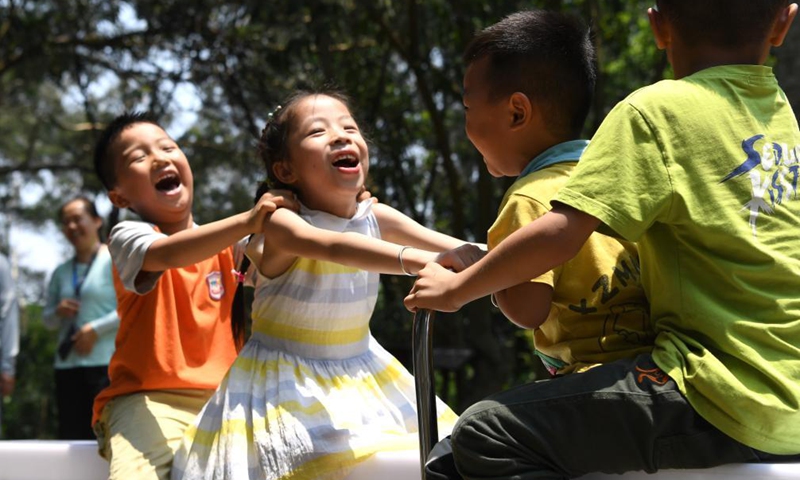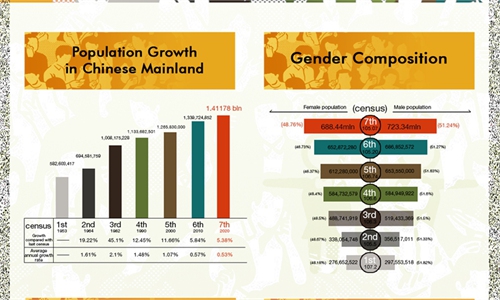China to allow couples to have 3 children, step 'leading to fertility-friendly society'

Parents and their babies participate in a baby crawling contest at a shopping center in Daxing District, Beijing, capital of China, Sept. 13, 2020. (Xinhua/Li Xin)
China on Monday announced to further lift its family planning policy to allow each couple to have up to three children after the number of the country's newborns declined for four years straight, a major policy shift from the current two-child policy. Chinese demographers believed the new move was not simply a birth stimulation plan, but a significant step leading to more policy changes in improving China's demographic structure and actively responding to the aging trend.
The relaxation of the policy may not reverse the major trend of declining birth rate and aging population, but it sent a clear signal to encourage births and is part of efforts to build a fertility-friendly society, observers said.
Chinese demographers also said that along with the three-child policy, China will soon offer more detailed support measures for marriage and reducing child-raising burdens and healthcare for seniors which are more important for raising the fertility rate, slowing down the aging problem and balancing the demographic structure. In the next step, they said that China is likely to remove the decades' long family planning policy to encourage more births as China's population begins to shrink as early as 2022.
Xi Jinping, general secretary of the Communist Party of China (CPC) Central Committee, on Monday chaired a meeting of the Political Bureau of the CPC Central Committee to hear reports on major policy measures to actively address the aging population trend during the 14th Five-Year Plan period (2021-25). The meeting reviewed a decision on improving birth policies to promote long-term balanced population growth.
Further optimizing the family planning policy to allow each couple to have three children and implementing related supporting measures is conducive to improving China's population structure and implementing the national strategy of actively responding to aging population as well as maintaining China's advantage in human resources, the meeting said.
The meeting stressed that Party committees and governments at all levels should strengthen overall planning and policy coordination in implementing the three-child policy. They should also promote the coordination of the family planning policy and related economic and social policies, and improve the mechanism for assessing the impact of major economic and social policies on population growth.
Du Peng, a professor at the School of Sociology and Population Studies at Renmin University of China, told the Global Times on Monday that the three-child policy announced on Monday is not a surprise and it has been made "at the right time" as relevant departments have been looking to optimize the current population policy for a long time and the recent results from the seventh national population census have signaled the urgency.
China released its seventh population census results earlier this month, which showed that China's population continues to grow more slowly than in the past. Its labor force also shrank more rapidly over the past decade while the aging population trend continued to deepen. Chinese demographers said that the results from the census would serve as an important reference for China's population and economic policy adjustment as well as plans to put off retirement.
China recorded 12 million births in 2020, marking a drop for the fourth consecutive year, according to the seventh national population census communiqué released by the National Bureau of Statistics this month.
It was prepared for at least a year and showed that the consensus on implementing the three-child policy has gained stronger recognition after the release of the seventh national census, Liu Zhijun, a deputy head of the Social Science Experiment Center of Zhejiang University, told the Global Times.
According to Liu, some people have already been let off from paying fines if nobody reported them to the local government regarding their third child. To this group, the policy is a timely measure to allow them to have their third child legitimately.
The three-child policy has gained widespread attention on Chinese social media, as several related topics had made the hot topic list on Sina Weibo by Monday afternoon.
Chinese netizens had mixed reactions to the policy, as some said they were relieved they could finally prepare to have a new baby but many also said that they would not have three children even with the policy being implemented due to great financial and educational burdens in raising children.
Chinese observers said that many netizens did not fully understand the policy change, as they only saw the announcement but were not aware of the supporting measures which will be soon introduced.
The three-child policy is not simply a birth stimulation plan, but indicates more social and economic policy changes in the near future, which will tackle residents' concerns, with the latest three-child policy being one of the important steps in solving China's deepening aging population problem, analysts said.
Du said the three-child policy alongside future social and economic policies would help slow down China's deepening aging problem, as it could increase the number of future workers and further balance the development of the population.
Aside from introducing the above policies, to deal with the aging population problem, more measures would be adopted by China, including raising the retirement age, further developing human resources and adopting high technologies.
Addressing the aging population is significant to aiding national development in addition to improving the people's well-being, and is an important measure in achieving high-quality economic development, and maintaining national security and social stability, according to the meeting's agenda.
The meeting called for efforts to raise the statutory retirement age in a steady and gradual manner, improve a multi-level system for pension and aged-care social protection, explore building a systematic framework for long-term nursing insurance and accelerate the building of the systems for elderly care and health support that combine elderly care, health and medical services to be available both at homes and within communities.

Children play in an adventure playground at a tourist attraction in Nanning, south China's Guangxi Zhuang Autonomous Region, May 1, 2021. Saturday marks the first day of China's five-day May Day holiday. Photo: Xinhua
Policy package
The three-child policy is just the beginning of a slew of population and social policy changes to tackle China's population problem over the next few years, a Chinese demographer said.
Along with the three-child policy, China will offer more systematic support to further reduce burdens that have prevented people from having their first or second child, including increasing more nurseries, further promoting education equality and social resources allocation, and improving employment and services for seniors, Du said.
The supporting measures are more important as they would not only increase the desire for couples to have more children but will also generally encourage couples who previously didn't want to have children to change their minds, he said.
Monday's meeting also urged efforts to strengthen guidance on marriage and family values for young people at a marriageable age, rectify unhealthy social trends such as asking for exorbitant bride dowries, develop a nursery service system, promote education fairness and strengthen tax and housing support policies and protect women's rights in employment.
Chinese demographers said China's population development has entered a critical turning point with a rapidly aging population and the slower growth in population will soon reach a point where a five-decade trend of growth will be put to an end, and the three-child policy and its supporting measures will help slow the worsening population structure trend, although unlikely to avert it completely, and China may further adjust its family planning policy in the next two years.
Huang Wenzheng, a demography expert and senior researcher from the Center for China and Globalization, told the Global Times on Monday that he estimated the three-child policy will allow China to have around 300,000 to 500,000 extra newborns each year over the next few years, which could slow the trend of population decline.
The number of newborns in China in 2020 was 12 million, down from 14.65 million in 2019, according to the seventh national population census communiqué released by National Bureau of Statistics this month.
But it will not reverse China's overall trend of population decline, and stronger measures such as removing the family planning policy to bring about a birth encouragement policy is likely to follow, demographers said.
He Yafu, an independent demographer, told the Global Times on Monday he predicted that despite the three-child policy, China's population is likely to start to decline as early as 2022, and that is when China is likely to consider formal removal of the family planning policy.
The three-child policy is just the beginning of a slew of population and social policy changes to tackle China's population problem over the next few years, a Chinese demographer said.
Along with the three-child policy, China will offer more systematic support to further reduce burdens that have prevented people from having their first or second child, including increasing more nurseries, further promoting education equality and social resources allocation, and improving employment and services for seniors, Du said.
The supporting measures are more important as they would not only increase the desire for couples to have more children but will also generally encourage couples who previously didn't want to have children to change their minds, he said.
Monday's meeting also urged efforts to strengthen guidance on marriage and family values for young people at a marriageable age, rectify unhealthy social trends such as asking for exorbitant bride dowries, develop a nursery service system, promote education fairness and strengthen tax and housing support policies and protect women's rights in employment.
Chinese demographers said China's population development has entered a critical turning point with a rapidly aging population and the slower growth in population will soon reach a point where a five-decade trend of growth will be put to an end, and the three-child policy and its supporting measures will help slow the worsening population structure trend, although unlikely to avert it completely, and China may further adjust its family planning policy in the next two years.
Huang Wenzheng, a demography expert and senior researcher from the Center for China and Globalization, told the Global Times on Monday that he estimated the three-child policy will allow China to have around 300,000 to 500,000 extra newborns each year over the next few years, which could slow the trend of population decline.
The number of newborns in China in 2020 was 12 million, down from 14.65 million in 2019, according to the seventh national population census communiqué released by National Bureau of Statistics this month.
But it will not reverse China's overall trend of population decline, and stronger measures such as removing the family planning policy to bring about a birth encouragement policy is likely to follow, demographers said.
He Yafu, an independent demographer, told the Global Times on Monday he predicted that despite the three-child policy, China's population is likely to start to decline as early as 2022, and that is when China is likely to consider formal removal of the family planning policy.






